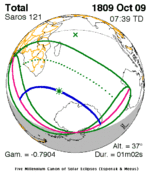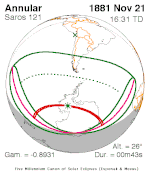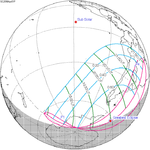

|
m r2.7.1) (Robot: Adding fa:خورشیدگرفتگی ۱۷ فوریه ۲۰۲۶
|
No edit summary
|
||
| (24 intermediate revisions by 20 users not shown) | |||
| Line 1: | Line 1: | ||
{{short description|Future annular solar eclipse}} |
|||
{{Solareclipse200_db|Infobox Solar eclipse2|2026Feb17}} |
|||
{{Infobox solar eclipse|2026Feb17}} |
|||
An annular [[solar eclipse]] will occur on February 17, 2026. {{Annular solar eclipse summary}} |
|||
An annular [[solar eclipse]] will occur at the Moon’s [[Lunar node|ascending node]] of orbit on Tuesday, February 17, 2026, with a [[Magnitude of eclipse|magnitude]] of 0.963. A [[solar eclipse]] occurs when the [[Moon]] passes between [[Earth]] and the [[Sun]], thereby totally or partly obscuring the image of the Sun for a viewer on Earth. An annular solar eclipse occurs when the Moon's [[apparent diameter]] is smaller than the Sun's, blocking most of the Sun's light and causing the Sun to look like an [[Annulus (mathematics)|annulus]] (ring). An annular eclipse appears as a partial eclipse over a region of the Earth thousands of kilometres wide. |
|||
Annularity will be visible over [[Antarctica]] only. However, the partial eclipse will be visible from the very southern tip of [[Argentina]] and [[Chile]], as well in much of [[Southern Africa]] (such as in [[South Africa]], [[Mozambique]], and [[Madagascar]]). |
|||
== Images == |
== Images == |
||
[[File:SE2026Feb17A.gif]]< |
[[File:SE2026Feb17A.gif]]<br />Animated path |
||
== Related eclipses == |
== Related eclipses == |
||
=== |
=== Eclipses in 2026 === |
||
* '''An annular solar eclipse on February 17.''' |
|||
{{Solar eclipse set 2026-2029}} |
|||
* [[March 2026 lunar eclipse|A total lunar eclipse on March 3]]. |
|||
* [[Solar eclipse of August 12, 2026|A total solar eclipse on August 12]]. |
|||
* [[August 2026 lunar eclipse|A partial lunar eclipse on August 28]]. |
|||
=== Metonic === |
|||
* Preceded by: [[Solar eclipse of April 30, 2022]] |
|||
* Followed by: [[Solar eclipse of December 5, 2029]] |
|||
=== Tzolkinex === |
|||
* Preceded by: [[Solar eclipse of January 6, 2019]] |
|||
* Followed by: [[Solar eclipse of March 30, 2033]] |
|||
=== Half-Saros === |
|||
* Preceded by: [[February 2017 lunar eclipse|Lunar eclipse of February 11, 2017]] |
|||
* Followed by: [[February 2035 lunar eclipse|Lunar eclipse of February 22, 2035]] |
|||
=== Tritos === |
|||
* Preceded by: [[Solar eclipse of March 20, 2015]] |
|||
* Followed by: [[Solar eclipse of January 16, 2037]] |
|||
=== Solar Saros 121 === |
|||
* Preceded by: [[Solar eclipse of February 7, 2008]] |
|||
* Followed by: [[Solar eclipse of February 28, 2044]] |
|||
=== Inex === |
|||
* Preceded by: [[Solar eclipse of March 9, 1997]] |
|||
* Followed by: [[Solar eclipse of January 27, 2055]] |
|||
=== Triad === |
|||
* Preceded by: [[Solar eclipse of April 19, 1939]] |
|||
* Followed by: [[Solar eclipse of December 19, 2112]] |
|||
=== Solar eclipses of 2026–2029 === |
|||
{{Solar eclipse set 2026–2029}} |
|||
=== Saros 121 === |
|||
{{Solar Saros series 121}} |
|||
=== Metonic series === |
|||
{{Metonic eclipse set info}} All eclipses in this table occur at the Moon's ascending node. |
|||
{| class="wikitable collapsible collapsed" |
|||
!colspan=5| 21 eclipse events, progressing from south to north between July 13, 2018 and July 12, 2094 |
|||
|- |
|||
!July 12–13 |
|||
!April 30-May 1 |
|||
!February 16–17 |
|||
!December 5–6 |
|||
!September 22–23 |
|||
|- |
|||
!117 |
|||
!119 |
|||
!121 |
|||
!123 |
|||
!125 |
|||
|- style="text-align:center;" |
|||
|[[File:SE2018Jul13P.png|150px]]<br />[[Solar eclipse of July 13, 2018|July 13, 2018]] |
|||
|[[File:SE2022Apr30P.png|150px]]<br />[[Solar eclipse of April 30, 2022|April 30, 2022]] |
|||
|[[File:SE2026Feb17A.png|150px]]<br />[[Solar eclipse of February 17, 2026|February 17, 2026]] |
|||
|[[File:SE2029Dec05P.png|150px]]<br />[[Solar eclipse of December 5, 2029|December 5, 2029]] |
|||
|[[File:SE2033Sep23P.png|150px]]<br />[[Solar eclipse of September 23, 2033|September 23, 2033]] |
|||
|- |
|||
!127 |
|||
!129 |
|||
!131 |
|||
!133 |
|||
!135 |
|||
|- style="text-align:center;" |
|||
|[[File:SE2037Jul13T.png|150px]]<br />[[Solar eclipse of July 13, 2037|July 13, 2037]] |
|||
|[[File:SE2041Apr30T.png|150px]]<br />[[Solar eclipse of April 30, 2041|April 30, 2041]] |
|||
|[[File:SE2045Feb16A.png|150px]]<br />[[Solar eclipse of February 16, 2045|February 16, 2045]] |
|||
|[[File:SE2048Dec05T.png|150px]]<br />[[Solar eclipse of December 5, 2048|December 5, 2048]] |
|||
|[[File:SE2052Sep22A.png|150px]]<br />[[Solar eclipse of September 22, 2052|September 22, 2052]] |
|||
|- |
|||
!137 |
|||
!139 |
|||
!141 |
|||
!143 |
|||
!145 |
|||
|- style="text-align:center;" |
|||
|[[File:SE2056Jul12A.png|150px]]<br />[[Solar eclipse of July 12, 2056|July 12, 2056]] |
|||
|[[File:SE2060Apr30T.png|150px]]<br />[[Solar eclipse of April 30, 2060|April 30, 2060]] |
|||
|[[File:SE2064Feb17A.png|150px]]<br />[[Solar eclipse of February 17, 2064|February 17, 2064]] |
|||
|[[File:SE2067Dec06H.png|150px]]<br />[[Solar eclipse of December 6, 2067|December 6, 2067]] |
|||
|[[File:SE2071Sep23T.png|150px]]<br />[[Solar eclipse of September 23, 2071|September 23, 2071]] |
|||
|- |
|||
!147 |
|||
!149 |
|||
!151 |
|||
!153 |
|||
!155 |
|||
|- style="text-align:center;" |
|||
|[[File:SE2075Jul13A.png|150px]]<br />[[Solar eclipse of July 13, 2075|July 13, 2075]] |
|||
|[[File:SE2079May01T.png|150px]]<br />[[Solar eclipse of May 1, 2079|May 1, 2079]] |
|||
|[[File:SE2083Feb16P.png|150px]]<br />[[Solar eclipse of February 16, 2083|February 16, 2083]] |
|||
|[[File:SE2086Dec06P.png|150px]]<br />[[Solar eclipse of December 6, 2086|December 6, 2086]] |
|||
|[[File:SE2090Sep23T.png|150px]]<br />[[Solar eclipse of September 23, 2090|September 23, 2090]] |
|||
|- style="text-align:center;" |
|||
!157 |
|||
|- style="text-align:center;" |
|||
|[[File:SE2094Jul12P.png|150px]]<br />[[Solar eclipse of July 12, 2094|July 12, 2094]] |
|||
|} |
|||
==References== |
==References== |
||
{{reflist}} |
{{reflist}} |
||
{{commons category|Solar eclipse of February 17, 2026}} |
|||
== External links == |
== External links == |
||
| Line 18: | Line 121: | ||
{{Solar eclipses}} |
{{Solar eclipses}} |
||
[[Category:Annular solar eclipses|2026 2 17]] |
|||
[[Category:2026 in science]] |
[[Category:2026 in science]] |
||
[[Category: |
[[Category:21st-century solar eclipses|2026 2 17]] |
||
[[Category:Future solar eclipses|2026 2 17]] |
|||
{{Solar-eclipse-stub}} |
{{Solar-eclipse-stub}} |
||
[[fa:خورشیدگرفتگی ۱۷ فوریه ۲۰۲۶]] |
|||
[[fr:Éclipse solaire du 17 février 2026]] |
|||
[[zh:2026年2月17日日食]] |
|||
| Solar eclipse of February 17, 2026 | |
|---|---|
| Type of eclipse | |
| Nature | Annular |
| Gamma | −0.9743 |
| Magnitude | 0.963 |
| Maximum eclipse | |
| Duration | 140 s (2 min 20 s) |
| Coordinates | 64°42′S 86°48′E / 64.7°S 86.8°E / -64.7; 86.8 |
| Max. width of band | 616 km (383 mi) |
| Times (UTC) | |
| Greatest eclipse | 12:13:06 |
| References | |
| Saros | 121 (61 of 71) |
| Catalog # (SE5000) | 9565 |
An annular solar eclipse will occur at the Moon’s ascending node of orbit on Tuesday, February 17, 2026, with a magnitude of 0.963. A solar eclipse occurs when the Moon passes between Earth and the Sun, thereby totally or partly obscuring the image of the Sun for a viewer on Earth. An annular solar eclipse occurs when the Moon's apparent diameter is smaller than the Sun's, blocking most of the Sun's light and causing the Sun to look like an annulus (ring). An annular eclipse appears as a partial eclipse over a region of the Earth thousands of kilometres wide.
Annularity will be visible over Antarctica only. However, the partial eclipse will be visible from the very southern tip of Argentina and Chile, as well in much of Southern Africa (such as in South Africa, Mozambique, and Madagascar).
This eclipse is a member of a semester series. An eclipse in a semester series of solar eclipses repeats approximately every 177 days and 4 hours (a semester) at alternating nodes of the Moon's orbit.[1]
| Ascending node | Descending node | |||||
|---|---|---|---|---|---|---|
| Saros | Map | Gamma | Saros | Map | Gamma | |
| 121 | 2026 February 17 Annular |
−0.97427 | 126 | 2026 August 12 Total |
0.89774 | |
| 131 | 2027 February 6 Annular |
−0.29515 | 136 | 2027 August 2 Total |
0.14209 | |
| 141 | 2028 January 26 Annular |
0.39014 | 146 | 2028 July 22 Total |
−0.60557 | |
| 151 | 2029 January 14 Partial |
1.05532 | 156 | 2029 July 11 Partial |
−1.41908 | |
Partial solar eclipses on June 12, 2029, and December 5, 2029, occur in the next lunar year eclipse set.
Solar saros 121, repeating every about 18 years, 11 days, and 8 hours, contains 71 events. The series started with a partial solar eclipse on April 25, 944. It contains total eclipses from July 10, 1070, to October 9, 1809. It contains hybrid eclipses on October 20, 1827, and October 30, 1845. It contains annular eclipses from November 11, 1863, to February 28, 2044. The series ends at member 71 as a partial eclipse on June 7, 2206. The longest total eclipse occurred on June 21, 1629, with greatest duration of totality at 6 minutes and 20 seconds. The longest annular eclipse will occur on February 28, 2044, with greatest duration of annularity at 2 minutes and 27 seconds.[2]
| Series members 49–65 occur between 1801 and 2100: | ||
|---|---|---|
| 49 | 50 | 51 |
 October 9, 1809 |
 October 20, 1827 |
 October 30, 1845 |
| 52 | 53 | 54 |
 November 11, 1863 |
 November 21, 1881 |
 December 3, 1899 |
| 55 | 56 | 57 |
 December 14, 1917 |
 December 25, 1935 |
 January 5, 1954 |
| 58 | 59 | 60 |
 January 16, 1972 |
 January 26, 1990 |
 February 7, 2008 |
| 61 | 62 | 63 |
 February 17, 2026 |
 February 28, 2044 |
 March 11, 2062 |
| 64 | 65 | |
 March 21, 2080 |
 April 1, 2098 | |
The metonic series repeats eclipses every 19 years (6939.69 days), lasting about 5 cycles. Eclipses occur in nearly the same calendar date. In addition, the octon subseries repeats 1/5 of that or every 3.8 years (1387.94 days). All eclipses in this table occur at the Moon's ascending node.
| 21 eclipse events, progressing from south to north between July 13, 2018 and July 12, 2094 | ||||
|---|---|---|---|---|
| July 12–13 | April 30-May 1 | February 16–17 | December 5–6 | September 22–23 |
| 117 | 119 | 121 | 123 | 125 |
 July 13, 2018 |
 April 30, 2022 |
 February 17, 2026 |
 December 5, 2029 |
 September 23, 2033 |
| 127 | 129 | 131 | 133 | 135 |
 July 13, 2037 |
 April 30, 2041 |
 February 16, 2045 |
 December 5, 2048 |
 September 22, 2052 |
| 137 | 139 | 141 | 143 | 145 |
 July 12, 2056 |
 April 30, 2060 |
 February 17, 2064 |
 December 6, 2067 |
 September 23, 2071 |
| 147 | 149 | 151 | 153 | 155 |
 July 13, 2075 |
 May 1, 2079 |
 February 16, 2083 |
 December 6, 2086 |
 September 23, 2090 |
| 157 | ||||
 July 12, 2094 | ||||
This solar eclipse–related article is a stub. You can help Wikipedia by expanding it. |